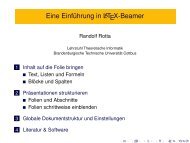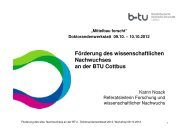Multilevel Graph Clustering with Density-Based Quality Measures
Multilevel Graph Clustering with Density-Based Quality Measures
Multilevel Graph Clustering with Density-Based Quality Measures
Create successful ePaper yourself
Turn your PDF publications into a flip-book with our unique Google optimized e-Paper software.
2.4 Fundamental <strong>Clustering</strong> Strategiesfirst bisectionsecond bisection(a) Recursive Bisection(b) Hierarchical <strong>Clustering</strong> and DendrogramFigure 2.3: Recursive Subdivision and Hierarchical <strong>Clustering</strong>s. The red dashed linemarks the cut through the dendrogram. The corresponding clustering is drawn byred circles.an example recursive bisection is shown in Figure 2.3a. The recursive applicationresults in a hierarchical clustering.Like agglomeration methods recursive subdivision is unable to correct errors.Moreover the subdivision methods work <strong>with</strong> a fixed number of clusters. This imposesa structure on the clusterings which may hide the correct structure [57]. Forexample a bisection of a graph <strong>with</strong> three clusters might falsely split one of theclusters into two parts. Further bisections will not correct this.Also other algorithms producing hierarchical clusterings exist. For example themerge steps in agglomeration methods and the connectivity components of dissectionmethods provide a cluster hierarchy. Such hierarchies are often drawn as a tree calleddendrogram. The root is a cluster containing all vertices and each leaf contains justa single vertex.To derive a normal, flat clustering a cut through this tree is searched as shown inFigure 2.3b. The simplest variants select the level <strong>with</strong> best modularity [59]. Moreelaborate implementations search for better clusterings by shifting the level up anddown in subtrees [63]. Of course this search is inherently limited by the underlyingtree.Multi-Level Approaches Multi-level methods were developed to improve the searchrange and speed of partition refinement methods by moving small vertex groups atonce. These groups and the connections between the groups are represented as acoarse graph. In this graph it is sufficient for the refinement to move just singlecoarse-vertices. Applying this idea recursively leads to multi-level refinement methodslike [41, 78]. Karypis and Kumar [43] were the first proposing to use agglomerationmethods to already optimize the clustering quality during the constructionof coarse graphs. However up to now no multi-level refinement algorithm exists todirectly optimize the modularity.23






